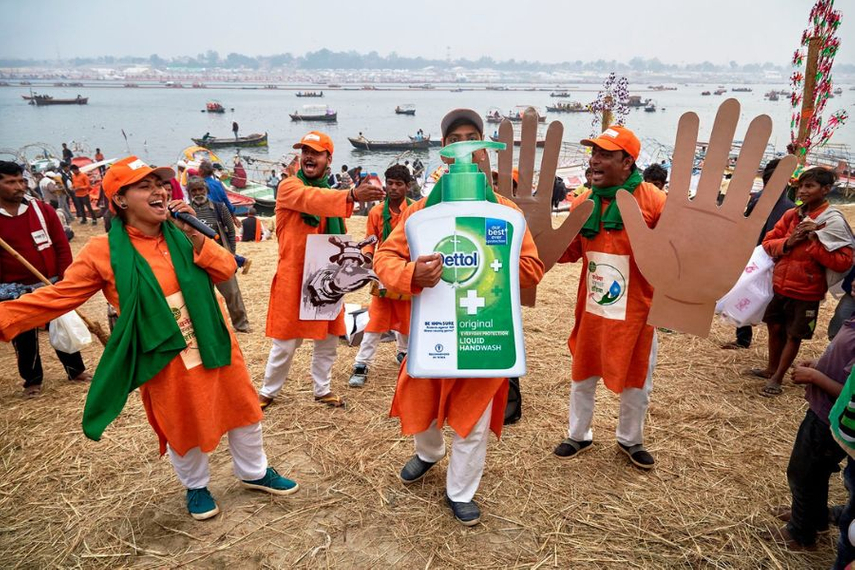
The Maha Kumbh Mela, held every 12 years, is a confluence of faith, culture, and commerce. Spanning 45 days and drawing an estimated 400 million visitors to Prayagraj this year, it’s the world’s largest congregation. Uttar Pradesh created its 76th district, a sprawling 10,000-acre Maha Kumbh Nagar, specifically for this pilgrimage. It can accommodate up to 1 crore people at a time and is connected to the snan ghats (bathing areas) with pontoon-supported bridges.
Such a staggering turnout is a marketer’s dream, offering brands a unique platform to reach a diverse and engaged audience. Yet, this rare opportunity demands careful balancing of promotional aspirations with the event’s deep spiritual significance.
ICICI Bank is among the companies leveraging the Maha Kumbh’s colossal reach. It has set up a branch within the Mela grounds, providing essential banking services such as currency exchange, fund transfers, and forex services. Complementing this, a mobile ATM van will offer services ranging from cash withdrawals to credit card payments, stationed at various Prayagraj locations from 9:00 AM to 6:00 PM daily until the event’s conclusion on February 26. By embedding its presence in the festival’s fabric, the bank wants to position itself as a trusted partner for the millions of pilgrims seeking convenience amid the chaos.

IIFL Foundation, the CSR arm of IIFL Group, has also taken a humanitarian approach, introducing 15 boat ambulances to provide first-aid and emergency care. Collaborating with Bharat Scouts and Guides, the initiative is supported by a 50-member team and a health centre staffed with doctors and essential equipment. “We are genuinely excited to contribute to this historic event,” said Madhu Jain, Director of IIFL Foundation, highlighting the group’s efforts to ensure quicker response times for medical emergencies.
Innovations afloat
Innovation remains central to brand strategies at the Kumbh. Park+, an auto-tech app, launched Prayagraj’s first smart parking management system that will accommodate over 5 lakh private vehicles. Pilgrims visiting the city can use this app to easily discover, book and prepay for a car parking spot at a government approved parking area. Car owners can also use their FASTag on their car to pay for a parking spot, without any human intervention, which is a first of its kind initiative in Prayagraj.

Tata Play Aradhana has rolled out uninterrupted, ad-free coverage of the Mela, including Shahi Snans, Ganga aartis (prayers), and Akhara processions. Meanwhile, Kuku FM launched its Bhakti App to coincide with the Maha Kumbh Mela. It will deliver devotional content tailored to the spiritual fervour of the event.
ITC’s FMCG brands Bingo! and Mangaldeep are leveraging with devotees through immersive initiatives. Bingo! will showcase Uttar Pradesh’s culture at its activity booth with reels on local songs and fusion dishes blending regional flavours with Tedhe Medhe snacks. Focusing on spirituality, Mangaldeep Agarbatti will participate in rituals like havans, hosting bhajans, and using augmented reality to bring devotional elements like ‘Kumbh Snan’ and ‘Deepdaan’ into homes.
Past campaigns also demonstrate the creative possibilities that brands have leaned on. Reckitt’s Dettol Banega Swasth India initiative this year has partnered with Akharas to distribute soaps and promote handwashing at food-serving areas, while also supporting sanitation workers. This builds on Reckitt’s earlier efforts to instil hygiene practices at mass gatherings.
Similarly, Coca-Cola’s ongoing emphasis on recycling and sustainable practices aligns its brand message with collective environmental responsibility. Greishma Singh, vice president for marketing at Coca-Cola India and South West Asia said, “We will be pairing our diverse portfolio of beverages with local foods and flavours and bringing to life immersive experiences to make Maha Kumbh even more memorable for all who visit. We are committed to creating social impact through multiple initiatives at the event, that showcase the potential of repurposed packaging and raise awareness about recycling to inspire collective action.”
Kumbh’s economic magnetism
The Maha Kumbh Mela’s economic footprint is staggering. Uttar Pradesh Chief Minister Yogi Adityanath projects a contribution of up to INR 2 lakh crore to the state’s economy this year, a significant leap from 2019’s INR 1.2 lakh crore. The Confederation of Indian Industry (CII) estimates that brands will spend INR 1,800 crore to INR 2,000 crore on advertising. This would encompass hoardings, banners, LED displays, and mobile applications.
Yet, beyond the numbers lies the unparalleled opportunity for product trials. With 400 million attendees cutting across demographics, the Mela is a marketer’s laboratory.
Sandeep Goyal, chairman of Rediffusion, however, critiques this approach. “Almost none of the Kumbh ideas stay alive beyond the Mela, despite all the hype. If the Mela is a lab, successful ideas should translate into real-world strategies,” he opined.
While the Mela offers brands a chance to marry social responsibility with visibility, the stakes are high. Religious sensibilities can be unforgiving, making prudence essential.
Goyal’s assertion that bias in a Hindu-majority gathering is “prefactored” highlights the need for culturally neutral offerings. For instance, Reckitt’s hygiene initiatives and Lifebuoy’s ‘Roti Reminder’ campaign during the 2013 Kumbh managed to resonate without alienating the audience.
However, not all campaigns hit the mark. Ramesh Narayan, founder of Canco Advertising, warns of the risks. “New brands must identify their audience carefully. A scattergun approach could yield baffling results,” he cautioned.
The Kumbh’s diverse crowd, spanning socio-economic and geographic divides, demands hyper-local and emotionally resonant messaging. Those trying the one-size-fits-all approach are likelier to see their ad spends flow down the ghats.
Treading lightly on sacred ground
The Kumbh’s spiritual underpinnings necessitate marketing strategies that enhance, rather than exploit, the event’s sanctity. Reckitt’s engagement of Kalpvasis (devotees staying for 45 days) through soap distribution and hygiene awareness exemplifies responsible branding. Similarly, Harpic’s past efforts to promote sanitation aligned with the Mela’s themes of purity and respect.
Yet, the line between engagement and opportunism is thin. A marketing misstep risks offending millions, as evidenced by past controversies in religious advertising. Industry experts caution against using the Kumbh solely as a product-testing ground. Only offerings that align with the event’s ethos should be introduced.
For brands, the Maha Kumbh Mela is more than an event; it’s a cultural touchstone. The intersection of ancient tradition and modern commerce provides a unique space for emotional storytelling. From hygiene campaigns to tech-driven solutions, brands have a rare chance to embed themselves in the cultural memory of India.
However, as Narayan aptly summarises, success hinges on a brand’s ability to navigate this complex terrain with authenticity and respect: “Participation isn’t just about visibility; it’s about becoming part of a lasting cultural narrative.”
As the Maha Kumbh unfolds, it’s clear that brands are exploring its vast potential. But the true test lies in whether these campaigns transcend the event, creating enduring connections with consumers. For now, the Maha Kumbh remains an unparalleled stage for innovation, engagement, and reflection—both for the pilgrims who gather and the brands eager to reach them.


.jpg&h=334&w=500&q=100&v=20250320&c=1)


.jpg&h=334&w=500&q=100&v=20250320&c=1)






.jpg&h=268&w=401&q=100&v=20250320&c=1)
.jpg&h=268&w=401&q=100&v=20250320&c=1)

.jpg&h=268&w=401&q=100&v=20250320&c=1)
.jpg&h=268&w=401&q=100&v=20250320&c=1)
.jpg&h=268&w=401&q=100&v=20250320&c=1)
.jpg&h=268&w=401&q=100&v=20250320&c=1)
.jpg&h=268&w=401&q=100&v=20250320&c=1)
